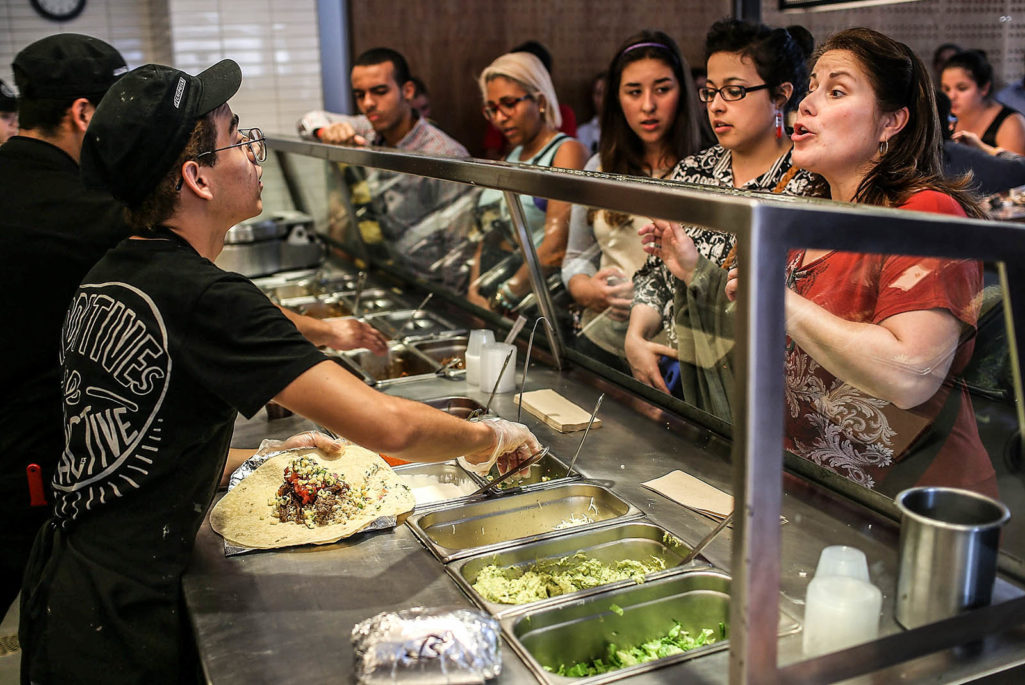Six Reasons Why Green is the New Black

Chipotle restaurant workers fill orders for customers. Chipotle, and other so-called ‘Green Giants,’ prove that businesses predicated on sustainability and social good aren’t just a viable alternative to business as usual. They are more profitable and more sustainable financially.
Photo: Joe Raedle/Getty Images
Monthly feature: Innovation in Perspective, from GE Reports
Today, many business leaders know the world has changed. They are wrestling with the new mandate to incorporate sustainability and social good into their businesses and brands.
But most companies struggle to figure out how to do this while continuing to meet their quarterly sales and earnings targets. They may have tried “green marketing” and met limited success. Or they may have skeptical shareholders convinced that this is a passing fad, or one that is just for hippies and tree huggers.
Over the eight years I’ve spent compiling evidence that brands can both maximize profit and be a force for social good, the question I’ve been asked most often is: “What’s the business case for sustainability?”
The answer is: a $9 burrito.
Chipotle—which sources its meat from farmers who commit to employ more responsible practices and uses its marketing dollars to advocate for ethical, sustainable farming—is doing $1 billion in revenue each quarter. And it is not an anomaly. It is one of at least nine companies globally—including Nike, Tesla, GE and others—with more than $1 billion in annual revenue directly attributable to a product, service or line of business with sustainability or social good at its core.
Together, these “Green Giants” prove that businesses predicated on sustainability and social good aren’t just a viable alternative to business as usual. They are more profitable and more sustainable financially. But how have they converted sustainability or social responsibility into billion-dollar revenue streams, and how can you follow their example? What has enabled these companies to become successful businesses by any standard, not just the standard of sustainable business?
Reputation today is built through actions, not advertising.
My book, “Green Giants,” isolates six key factors or traits that Green Giants share and that have directly contributed to their uncommon success. These are:
- The Iconoclastic Leader. In each case, the sustainability journey can be traced back to one individual who started it all. These remarkable leaders embody “4 Cs.” They are marked by an inner sense of conviction, the courage to stand up and change things, commitment to see change through, despite obstacles, and a constructive contrarian Surprisingly for leaders noted for their sustainable business leadership, sustainability is not a job title prerequisite; seven of the nine are CEOs. To drive business transformation on this scale, it seems, you have to be the boss.
- Disruptive Innovation. Each revenue stream is not founded on a slightly greener or more socially conscious version of an existing product, but on an innovation that disrupted a category. Consider Tesla’s Roadster or Toyota’s Prius, the first automotive alternatives to the internal combustion engine in 80 years. Or Chipotle, which overturned the economics of the fast-food category to prove that cheaper does not always mean better. The Green Giants are making things better, not just greener, and inventing the products and services of the 21st century in the process.
- A Higher Purpose. The Green Giants are guided by a purpose beyond profit. It may seem like a paradox, but businesses with a purpose beyond profit tend to outperform the competition on—you guessed it—profit. Why? Because a purpose serves as a succinct statement of your corporate strategy; it answers the question, “Why does this business exist?” Increasingly, employees, customers, consumers and stakeholders are drawn to companies with an answer to that question, one that aligns with their own personal purpose.
- Built In, Not Bolted On. Much of the business establishment regards sustainability as an expense to be shouldered, an initiative to be undertaken or a department to be built—a sideshow to the main event of making money. But for Green Giants, sustainability means business, and they integrate sustainability into the core structures of their business. These include the company’s governance structure, its incentive structure, its cost structure and its organizational structure. For example, Unilever CEO Paul Polman has his compensation tied to his delivery of the Sustainable Living Plan, while GE has Ecomagination champions embedded all across its business. Green Giants reframe sustainability from a vertical function to a business horizontal, and, in the process, they enable it to become a revenue driver, not a drag.
- Mainstream Appeal. If your product targets only what I call a Super Green niche, it’s hard to reach $1 billion in revenue because there simply aren’t enough people who take green values seriously enough to get you there. Green Giants understand that while for most people, sustainability is increasingly desirable, it comes in as runner-up in the relevance stakes to whatever primary functional or emotional benefit they seek—be it flavor, functionality, cachet, health or value. So Green Giants build their marketing around human wants, needs and desires first, showing that sustainability delivers the benefits people want, rather than focusing on the sustainability itself. That’s how to achieve appeal with mainstream customers or consumers.
- A New Behavioral Contract. Transparency, responsibility, collaboration: Today’s business buzzwords are alive and well at the Green Giants. But it’s more than talk. Reputation today is built through actions, not advertising. If the recent VW emissions scandal is a salutary example of what not to do, actions such as Nike disclosing every factory in its supply chain on a public website, Unilever’s proactive efforts to reduce the emissions generated from consumers’ showers (without pressure from stakeholders) or GE’s commitment to collaboration at scale in its Ecomagination challenges are the antidote to businesses behaving badly. Green Giants are forging a new behavioral contract with the rest of us—and behaving their way to billions in the process.
The UN estimates that the market for “green trade” will grow to $2.2 trillion by 2020. That’s trillion with a t in just a few short years. And Green Giants are the leaders in an inexorable business movement, seizing the market’s next great business opportunity.
But it’s their iconoclastic thinking, radical innovation, tenacious commitment, standout creativity and explosive growth that are driving this momentum, instead of the earnest themes of integrity, responsibility and altruism more commonly associated with sustainability. Ignore their example at your peril.
This piece first appeared in Perspectives, from GE Reports.




